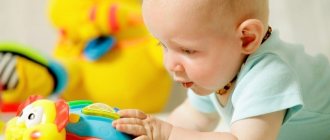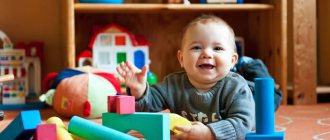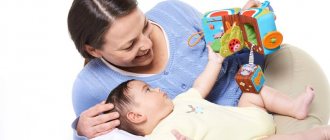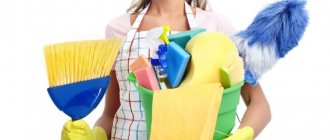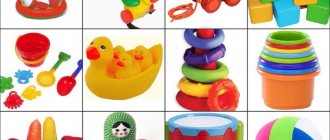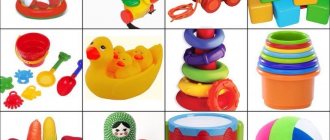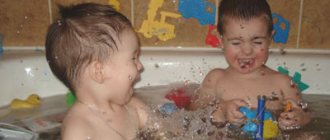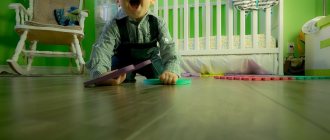Post memo. The original is taken here:
https://www.igraypodrastay.ru/razvivayuschie-zaniatia/1-5-2-goda/42-kak-razvivati-rebenka-1-5-goda.html
When you are involved in the development of a child, the question often arises - what needs to be developed? What else would you like to do? What to play with your child?
To be honest, similar questions arise from time to time for me. To help other mothers, I decided to make an approximate list of areas of development for a child aged 1.5 to 2 years.
So,
How to develop a child from 1.5 to 2 years old:
Development of logic.
1. “Collect only” (learn to select only certain items from scattered objects - according to mom’s instructions. For example, put only pine cones, only red objects, etc. in a box). 2. Learn to sort objects (by shape, size, color). 3. Assemble simple puzzles or pictures cut into pieces (at one and a half years old these will be two-piece puzzles; the average child usually learns to put together more complex shapes independently after two years). 4. Assemble from parts - games from soft construction toys (carpet, felt) or paper templates, by playing with which the child learns to put together simple figures - a house, a mushroom, etc. from 2-3 parts (homemade construction sets are much better, since the mother has the opportunity to make a construction set based on the individual characteristics of the child):
5. Games with insert frames and their paper counterparts:
6. Closer to two years - assembling a pyramid from cubes of different sizes:
7. Stack the cups, build a tower of cups:
8. A task for complicated classification such as “find the big yellow circle”, “find the small blue square” (such tasks are more suitable for children closer to two years old, provided that the child is already good at distinguishing objects by shape and color and has mastered the simplest sorting) . 9. Games with all sorts of sorters.
Development of attention.
- Game “Find a Pair” - with socks, mittens, cards (lotto).
- Game "What's in this room?" - according to mom’s instructions, look for “what is red, hard, soft, etc. in this room.”
- Game "Where in this room"? (find where in this room there is a polar bear, your favorite doll, etc.).
- “Find it by sound” - the mother hides a playing musical toy in the room - the baby must find it by sound.
- “Find Mom” is a game of hide and seek (the mother hides so that it is very easy to find her, sometimes she gives hints - calling the baby to her).
- “Find a similar pattern” is a variation of the game “find a pair” - find objects (handkerchiefs, mittens, hats) with the same pattern (usually drawn or printed manuals are used for this).
Studying the properties of objects:
- Big small.
- Names of colors (both basic - blue, red, etc. and atypical - light green, pink, etc.).
- Study of geometric shapes (circle, square, etc.).
- One is many.
- Hot Cold.
- High Low.
- Up down.
- Prepositions.
- Sad-cheerful.
10. Hard-soft. 11. Dirty-clean. 12. Front-back. 13. Dry-wet. 14. Prickly. 15. Smooth. 16. Rough. 17. Light - heavy.
Lexical topics:
- Dishes.
- Fish.
- Vegetation (trees, bushes, grass, flowers, leaves).
- Cars.
- Ship.
- Houses.
- Flowers.
- Mushrooms.
9. My house (kitchen, bathroom, toilet, hallway, living room, bedroom, children's room, closets). 10. City (streets, houses, courtyards, roadways, public transport, parks). 11. Vegetables, fruits. 12. Products, food. 13. Pets. 14. Wild animals. 15. Clothes. 16. Furniture. 17. Birds. 18. Parts of the body, parts of the face. 19. Insects (ant, bee, etc.). 20. Sun, clouds, moon, moon, stars, rain, snow, puddles.
Creation.
- Drawing: with wax crayons, paints, felt-tip pens (it’s better to take water-based ones (“washable”) - they wash well). Children at this age usually find it difficult to draw with pencils - you need to make a strong effort to leave a mark on the paper, and they also break quickly.
- Learn to use paints - wash the brush after each color, wet the brush in water.
- Finger painting.
- Drawing with a sponge (with stripes and stamps cut from a sponge for washing dishes; gouache or finger paints are used for painting with a sponge).
- Drawing silhouettes: a stencil is made from a sheet of paper - a simple silhouette is cut out inside the sheet - for example, a Christmas tree, a house, a mushroom. The stencil is placed on a blank sheet of paper, the child decorates the stencil window (silhouettes of a Christmas tree, mushrooms, etc.). At the end of the work, the stencil is removed and a cute children's creativity remains on the bottom sheet of paper.
- In a playful way, start learning to draw lines (vertical, horizontal), closer to 2 years - circles. It is important that the skills of drawing lines and circles at this age are very individual, some learn this later, some earlier, it is necessary to take into account the interest and abilities of the baby.
- Closer to two years, you can begin to master coloring (also very individually - after all, most children successfully master this skill somewhere after two). It is better to learn to paint with paints - this technique is much easier for a child. You can start learning by coloring silhouettes of fish, mushrooms, etc. cut out of paper.
- Modeling from plasticine, dough - learn to pinch off lumps, attach them to paper (perform compositions “feed the chicken with grains, make a cutlet for the dog,” etc.), make sausages, flat cakes, hide objects in plasticine/dough and find them, cut the dough with a knife, roll out with a rolling pin, leave imprints on the dough, cut out shapes with special molds (similar to cookie cutters). In the modeling skills described, everything is also individual - a child will easily learn something at 1.5 years, something will “come” after two - it’s different for everyone.
- Applique made of paper (of various textures), applique made of torn paper, applique made of crumpled paper.
10. Application with cereals. 11. Applique on the dough (various objects are laid out on the dough (beans, mosaics, acorns, etc. and pressed into the dough - interesting patterns are obtained).
12. Crafts that combine various techniques (modeling and modeling, applique and modeling, etc.).
Consultation for parents “What to do with a 1.5–2 year old child at home”
Elena Timofeeva
Consultation for parents “What to do with a 1.5–2 year old child at home”
Consultation for parents
“What 1.5-2 year old child at home ”
.
The development of a 1.5-2 year old child requires a lot of attention and participation from parents , because activities with a child at this age are aimed at understanding the world around them and acquiring skills necessary in later life. This important stage of life should be not only educational, but also interesting.
Parents are thinking about what 1.5-2 year old child at home . This question is especially relevant during quarantine. Activities for a small family member should not only be educational, but also exciting.
What can you do ?
We offer several options (we are sure that everyone knows them, but they have forgotten)
.
1. Kinetic (plastic)
sand.
One of the useful inventions of mankind was this very product - kinetic sand, which is also called plastic due to its unique properties of maintaining the flowability of ordinary dry sand and holding its shape perfectly, like wet sand. Thanks to these features, kinetic sand is pleasant to the touch, the child enjoys playing with it, kneading it in his hands, and pouring it from one container to another. This develops imagination and fine motor skills, which, in turn, has an active influence on the development of speech. It’s not without reason that they say: “ A child’s is at his fingertips.”
.
Nerve endings located at the fingertips stimulate areas of the brain responsible for the development of a child's . Therefore, if you don’t yet know what to do with your child at home , you should acquire such useful children’s entertainment. Plastic sand can also be colored, placed in transparent jars; the set may contain various molds with which you can fold figures, build towers, mountains, entire cities - exciting activities for a child of two years old , from which he will not want to tear himself away.
2. Play dough.
You can entertain your baby by modeling figures from dough specially prepared for this purpose. You can make it yourself by adding more salt and food coloring for color. Salt is needed so that the baby does not want to chew or swallow it. Modeling dough is also sold in children's stores, but its composition can cause allergies in children, so if the child is allergic , it is better to refrain from purchasing it. The soft colored dough, easily kneaded in the hands, will please the baby, and by showing him how to roll balls and sausages, you can captivate the baby in this process for a long time. Playing with dough is also very useful for the development of hand motor skills and has a positive effect on the mental and emotional development of the child . Another significant advantage of such entertainment is that the child can play with the dough on his own for a while, while the mother can do household chores .
3. Drawing.
Drawing with your baby is not only interesting, but also fun, because you can draw not only with a brush, pencils, felt-tip pens, paints, but also with your fingers using special finger paints. They are absolutely safe for the baby, even if he tastes them - it will not cause any harm thanks to the special safe manufacturing technology. Finger painting is not only useful for fine motor skills, but also fun for a child .
4. Lacing games.
Playing with figures - lacing - is educational and useful for learning how to dress independently. These can be wooden toys with removable parts - trains, butterflies, bracelets, trees, flowers, fish, or voluminous plastic toys - cars for boys, handbags for girls, boots, bracelets, buttons. Multi-colored large lacing games attract the baby's attention, arouse interest in the process of threading the lace into the holes, concentrate attention on details, develop coordination, attentiveness and perseverance. To entertain your child with such an exciting game, you can make such a lacing game yourself from scrap materials. It is enough to take colored cardboard, a hole punch and any shoelace from house shoes . With a little time and effort, two-year-old child will be provided with exciting activities
5. Puzzles.
Another interesting game for a two-year-old child will be puzzles. For younger children, large puzzles with a small number of parts are suitable (most often the picture is divided into two parts)
and simple bright pictures. To put the picture together, the baby will need the help of an adult. You should join the holes with the convex parts of the picture slowly, explaining to the child how to determine the parts that match each other. As soon as the baby understands the essence of the game, he will independently carry out this procedure, repeatedly assembling and disassembling the parts. After all, playing puzzles is such an exciting entertainment that even adults enjoy!
6. Empty boxes, cups, jars, containers.
If you have unnecessary empty boxes, containers, jars of creams, tubes at home It will be interesting for the baby to play with them, putting cubes, small toys, balls there, pouring cereal or sand. Such games are useful because they teach the child to adapt to everyday life - open and close lids, put and take out objects, getting used to correlating the volumes of certain things. At the age of 1.5-2 years , a child learns everything new , so he is characterized by long, monotonous, repetitive actions. When a child takes out and puts the same cubes in the same box minute after minute, it means he is learning new things. Do not distract him, do not try to switch his attention to other games, when he absorbs all the new knowledge, he will move on to a new game. At the moment when the child is captivated by the new box, the mother has the opportunity to go about her business .
7."Bag of Treasures"
.
A two-year-old child will love this exciting game! To organize an interesting journey for your child into the world of adult things, a mother will need to spend a little time, effort, a piece of her imagination and some household items that are always at hand. In a woman's bag (preferably with pockets and all sorts of compartments)
you need to put various adult things: a pen, a notepad, an old cell phone, a large button, a wallet without coins with unnecessary business cards or paper discount cards, a clean powder compact, a typewriter (for a boy, a doll (for a girl), a Kinder Surprise egg with a toy or a new one, not printed, purchased in advance at the store. In this
“treasure”
you can put any things at your mother’s discretion, the main thing is that they are safe and clean. Arrange things in compartments, pockets, close them with buttons and locks, and then give it away for the baby to study. Children love to tinker with adult things, so they feel your trust and involvement in the adult world. After all, it is important that
activities for a child of two years bring not only pleasure, but also practical benefits.
8. Reading children's books.
Young children quickly remember colorful, voluminous information. Therefore, a small supply of large-sized children's books will always be useful. Books laid out in the room will encourage the baby to look at the funny illustrations, and reading to the mother will cause calm and interest. By explaining pictures and showing letters, the mother develops the baby’s attention and horizons, and natural and life phenomena become clear to him. Reading is one of the most effective and educational learning methods for children at this age.
9. Cereals, pasta, sugar, salt.
In a separate container or bag, you can mix several types of cereals, pasta, sugar, salt, and hide various toys in them - a baby doll, a car, a Kinder Surprise egg, a button, a paint brush, a piece of modeling dough or plasticine. The baby will be happy to put his hands into the loose mixture and find new objects every time. This arouses interest in looking further; a heterogeneous environment has a beneficial effect on the development of fine motor skills and develops imagination. In addition to searching for toys, you can play sorting the ingredients - put larger pasta in a separate glass, grains in another, pour sugar and salt into a third. Having leveled the loose surface, you can draw various patterns, lay out pictures from pasta, toothpicks, cotton swabs, and disks. Activities for a two-year-old child with cereals and bulk products are one of the most useful and exciting, the main thing is to use your imagination!
Here are some examples of games with cereals.
Game "Build a pyramid"
Goal: Development of fine motor skills, coordination, dexterity. Development of emotional state.
Progress of the game: An adult offers the child a container filled with peas, beans.
Make a slide, a pyramid.
Equipment: Container with filler, fillers.
Game "Helper"
Goal: Development of fine and gross motor skills, coordination, dexterity. Instill hard work.
Progress of the game: An adult invites the child to transfer the contents from one container
to another.
Equipment: Containers with fillers, scoops, fillers.
Game "Cinderella"
Goal: Development of fine motor skills, coordination, dexterity. Know the container fillers. Development of emotional state.
Progress of the game: The adult invites the child from one container, where there are different fillers, to transfer them by type into different containers.
Equipment: Container with filler, various fillers.
Game "Find the treasure"
(
"Find the ball"
)
Goal: Development of fine motor skills. Familiarity with the quality of objects, size, shape.
Progress of the game: An adult buries an object in a container with filler and asks to find it. Then he buries several objects and offers to find them.
Equipment: Container with filling (peas, beans, millet)
; balls, cubes and toys.
Game "Plant a tree"
Goal: Development of coordination of movements, fine motor skills and eye. Instill love in the nature around us.
Progress of the game: An adult invites the child to fill the container with filler and “plant trees”
.
Equipment: Container with filler, tree models.
Game “Where are our hands”
Goal: Development of fine motor skills, coordination of movements. Development of dexterity and emotional attitude.
Progress of the game: An adult invites the child to hide his hands in a container with filler. An adult or another child must find his hand.
Equipment: Containers with various fillers.
Game "Cook porridge"
Goal: Development of fine motor skills, coordination of movements, dexterity, eye. Repeat the name of the cereal.
Progress of the game: An adult invites the child to go to the store , buy the necessary cereals and cook porridge.
Equipment: Various cereal fillers. Different containers.
10. Transfusion of water.
Children love to play with water, so you just need to set up a play area. Place bottles of different sizes, oil containers, plastic cups, disposable spoons, a funnel and other things as you wish in the bathroom or kitchen near the sink. Pour water into a basin and give all this magic to your child . Fishing in a basin - pour water into it, throw in toys and objects that do not sink, and give the baby a slotted spoon. Let him catch the toys and throw them into a bowl. For intrigue, you can create abundant foam to reduce visibility.
11. Dry fishing is done with tweezers.
You need to transfer pieces of cotton wool, foam rubber or cork from one container to another. Try to keep the cubes no larger than 1-2 cm with uneven edges.
12. Find objects.
There are many different versions of this game in which the child will independently look for something. Hide the phone, call it, and let your baby find it by sound. Hide pictures of animals, stuffed animals, or other items around the room. Pour out colorful socks and let your child match similar ones.
13. Clothespins.
Pull the rope just above the child , and attach light things (pictures, small soft toys)
.
Let the child reach and pull them off. We attach clothespins to a bucket, basin or saucepan, and the baby needs to unhook them and throw them into the container. Large paper clips so that the baby cannot stick it up his nose or swallow it. Pour a whole mountain of these large paper clips, preferably multi-colored, and invite them to play. Connect them together in a chain or create abstract figures, make beads for your mother or a “string”
for the car. Keep an eye on your baby so that he doesn't accidentally get hurt.
14. Unravel knots and braids.
You need to first tie a light knot or braid from sliding ropes, and let your baby unravel the braids and untie the knots. And the handles develop, and will take some time. Or, to begin with, you can wrap the child himself with these ropes - a leg , an arm, a finger, and let him unravel. And then you will be wrapped in the same “chains”
- everything is fair.
15. String beads on a thread.
You will need a lot of beads, buttons or other things with large holes. Take a wire or woolen thread and show your baby how to make beads for mom.
16. Bring something, I don’t know what...
The most popular way to keep a child busy , used by all parents . Ask your child to bring something from another room, take another item to dad or the kitchen, find a toy...
In general, mercilessly exploit your child as a loader - he will love it.
17. Children love to tear up magazines, and simple pieces of paper, postcards, pictures too.
But it’s better to put aside special magazines for these purposes, so as not to get upset and regret it later. At the end, you can arrange a whole leaf fall from these passages. Although it is safer to give a roll of inexpensive toilet paper, which can be endlessly unwound and torn into small pieces.
18. Blower
We take an ordinary rubber bulb with a hole, lay out cotton wool and fragments of leaves on the table (possibly from the previous leaf fall), and then blow it all off with the help of a pear. Very fun!
19. Balloons are a great way to keep a child busy .
Inflate a small balloon and let the baby run, throw, and catch up with it. Or put it under a T-shirt in the shape of a belly, he’ll be surprised. But be sure to keep an eye on the baby and do not give deflated balloons - the child will not be able to , but he can easily swallow them and suffocate.
20. Dance minute.
Find a song that your baby likes to dance to. And then start it and let it dance, and at this time you can do household chores - you have 3 minutes.
21. Free time.
Be sure to give your child time to come up with something to do on his own . This way he will develop imagination and independence, and it will be easier for you too.
22. TV.
As a last resort, you can use this method, although it is advisable not to use it child . But if you have to sit your baby in front of the screen, select in advance suitable educational cartoons that will be understandable and safe for the child .
Now parents have added several more options to 1.5-2 year old child occupied at home . Listen to your child , observe and offer only those games that he likes. Don't force him to draw if he wants to play active games. Only observing him will tell you how it will be better, and you yourself will come up with a million more activities .
Development of fine motor skills at 1.5 years.
- Develop motor skills by doing creative work - modeling, drawing, appliqué.
- Tear paper.
- Unwrap “surprises” (items wrapped in foil or several layers of paper).
- Sprinkle the cereal - with a spoon, with your hands, in glasses, look for hidden objects in it, prepare soup for the dolls.
- Playing with sorters and frame inserts.
- Learn to collect water from the table with a sponge.
- Learn to squeeze a sponge.
- Games with a pyramid (learn to string).
- Learn to string beads (special for children).
10. Games with large mosaics (closer to two years, individually). 11. Games with sand - learn to make Easter cakes, pies, pour, pour. 12. Games with Lego-type construction sets (connecting parts, separating parts). 13. Games with clothespins. 14. Cubes - build towers, build houses. 15. Learn to open and close all kinds of locks - either play with real ones, or make or buy a special board:
16. Learn to fold nesting dolls.
17. Play with knockers and hammers:
18. Remove small objects from a dish with a spoon (first with a tablespoon - this is easier, then with a teaspoon):
19. Use a spoon to catch small objects from the water. 20. Carry round objects in a spoon around the room. 21. Pour water into cups (ideally, play in the bathroom while bathing). 23. Pour water from a children's teapot into a cup. 23. Catch the balls in the water with a small strainer. 24. Beat the soap foam with a whisk (add a couple of drops of detergent to a plate of water). 25. Leave imprints on the dough with various figures and molds. 26. Draw with a stick on the ground or sand outside. 27. Finger paint on semolina. 28. Glue stickers. 29. Boxes, jars with lids, bags - learn to open and close. 30.Game “stick the figure in its place”:
31. Small rubber bands - learn to put on fingers, a pyramid stick, on small rubber toys:
32. “Piggy bank” - lower various small objects (buttons, coins, beans, pasta) into small slots on boxes and jars:
33.Learn to squeak with squeaking toys. 34. Spray yourself with sprinklers in the bathroom. 35.Massage your fingers with a massage ball (for example, accompanied by nursery rhymes). 36. Playing with small objects (if safety rules are followed) - buttons, pebbles, beads, etc.
37. Fasten and unfasten Velcro (on shoes, in special toys).
What to do with a 1 or 2 year old child?
Active games are just one of the options for sharing with your baby. A mother with a 1-year-old child can not only have fun, but also come up with many educational activities aimed at improving attention, thinking, motor skills and speech.
If you are a supporter of learning from the cradle, be sure to read the article, which discusses the most popular and successful, according to many experts, methods of early child development.
What games will a small child like?
- bubble. No kid will remain indifferent, watching how soap foam turns into rainbow bubbles, which can also be burst;
- drawing. You can interest a one-year-old toddler with special finger paints. A two-year-old child will be able to paint with watercolors, gouache paints and markers. The main thing is that all items are non-toxic;
- modeling Plasticine mass or salt dough is an ideal material for developing fine motor skills. Initially, mom needs to demonstrate how to roll balls and sausages, but leave more complex shapes for later;
- role-playing games. An interested child can happily feed the dolls, swaddle them, and put them in a crib or stroller for a long time. That is, the baby performs actions familiar to him;
- reading. Since children of one or two years old cannot yet understand the intricacies of fairy tales, it is best to read them short poems and nursery rhymes. Chukovsky, Barto - ideal option;
- educational toys. You definitely can’t do without them, so it’s important to stock up on cubes, pyramids, inserts, and construction sets with large, durable elements;
- Balloons. Another favorite activity for little children is to have fun with balloons. They can be inflated and deflated, painted with a felt-tip pen, depicting funny faces.
In addition, children love to play with water. A basin with water and rubber toys, a bath with dolls are a great option for entertainment. A child can splash around, pour water from various containers, wash his favorite dolls, and “wash” doll clothes.
Development of speech and articulation.
- Continue to learn onomatopoeia, teach how animals speak (kva-kva, boom-boom, etc.) - if the baby still speaks poorly. If speech development is normal, we continue to master those onomatopoeias that we have not yet mastered - we train the speech apparatus (we learn to pronounce complex sounds in simple sound combinations).
- We learn to blow (we blow soap bubbles, blow out candles, blow out cotton balls, etc.) - an individual skill - for many it develops after two years.
- Perform finger exercises to develop motor skills.
- “Mom-radio” - we try to talk a lot with the child, accompany the discussion with most actions and affairs (let’s put on a hat, pants, now we’ll eat, look at the flower, etc.). We try to speak to the child slowly and clearly (the slower and more clearly the mother speaks in everyday life, the easier, faster and more correctly the child begins to speak. Imagine a Chinese teacher who mumbles under her breath at a speed of 300 words per minute - how quickly can you speak Chinese? Chinese?).
- Read books.
- If the child speaks a sufficient number of words, recite poetry together (the mother begins - “our Tanya is loud...” the child continues - “crying!”) - usually this can be done on average - by the age of two (everyone is individual).
- If possible, encourage the child to speak and use onomatopoeia (say “give!”, “tell me what it is”, “tell me how the cat meows”, etc.).
- Play out various situations with toys, during which the child will say simple words and onomatopoeia (“let’s rock the doll, sing “a-a” to her,” “beep with the machine - “beep,” “ask the bear for a cup, say, “give me”) , bear!”, etc.).
Development of musical ear, sense of rhythm.
- Logorhythmics - dancing to music (for example Zheleznov).
- Playing children's musical instruments (including homemade ones).
- We get acquainted with the concepts of “loud - quiet” (playing spoons, drums loudly and quietly).
- Let's get acquainted with the concepts of "fast - slow music."
- “Listen! (we listen to different sounds - water dripping from a tap, birds chirping, trees rustling, a car driving, etc.).
- Let's get acquainted with the concepts of "noise - silence".
- Listening to classical music in the background.
- Active listening to classical music - discussion (“this is fast and cheerful music, it tells us how fast birds fly across the sky, we dance so quickly and cheerfully to it. But sad, calm music, this is a bored cat - we are so slow “We dance to it” - the child listens to the music, intuitively begins to understand that each music has its own character and characteristics).
- Ask the child to fulfill requests in a whisper (develops hearing - “bring a doll, give me a ball”).
Sensory development.
- Playing with different materials - pieces of fabric of different textures, balls, brush, etc.
- Application from materials of different textures (corrugated, velvet, sandpaper, cotton wool, fabric, etc.).
- Feeling various objects at home (the sofa is soft, the floor is hard, the cup of tea is warm, the kefir from the refrigerator is cold, the cat is fluffy, the brush is prickly, etc.).
- Feeling natural materials on the street - rough tree bark, wet water, smooth leaf, yarrow stem, dandelion, willow - fluffy, iron bench hard and cold, etc.)
- Play the match-the-pair game with pieces of fabric.
"My home is my castle". Montessori recommendations for arranging a home for a baby aged 1-2 years.
Montessori teachers always remind that the environment for the child should be comfortable and safe. It’s not so easy to grow and become independent when you are literally surrounded by insurmountable obstacles everywhere: chairs twice your height, a sink the size of an elephant, a cup that cannot be lifted and a spoon that does not fit into your mouth.
Before planning a Montessori lesson, look around your home and make sure your child has everything he needs:
- Comfortable place to sleep. The child must be able to lie down and get out of bed without adult help,
- Safe movement in the space allocated for the child. Close the sockets with special plugs, remove the wires, make sure that all furniture and decorative elements are securely fastened,
- Comfortable temperature and warm floor. Kids move around the floor a lot, so it’s worth covering it with warm carpets in advance or thinking about heated floors,
- Children's size furniture and tools: low chairs, table, shelves, drawers, ladder for access to the sink, convenient dishes
- An organized and accessible area for Montessori developmental activities. Use baskets, trays and bags for sorting and place the material on low shelves so that the baby can reach interesting items himself.
Gymnastics and coordination development.
- Logorhythmics - dancing to the music of the Zheleznovs and others.
- “Walk around the room without touching objects” - moving around a room cluttered with various obstacles.
- Learn to walk along the path (from books, ribbons, etc.).
- Step over obstacles (raising your legs high).
- Roll balls, cars.
- Throw balls.
- Learn to jump on the spot (you can learn to jump on a fitball or trampoline).
- Kick the ball.
- Crawling through a maze (store-bought or home-made - from chairs, etc.).
10. Climb: on the playground (slides, walls, etc.) and at home: at the sports complex, on the sofa - from the sofa, climb onto a chair, etc.
11. Learn to carry various objects on a tray.
12. On the street - walk more (but do not force the child to walk if he does not want to). If a child refuses to go, it means he is tired or cannot! By the age of three, the baby will get stronger and will happily stomp long distances (tested by millions of mothers of three-year-old children), if you rush things and “force” the child to walk, this can negatively affect the development of joints and bones.
13. Walk on inclined surfaces - uphill, downhill, along a ramp, up stairs.
14. Push a cart or a toy stroller. 15. Pull objects behind you on a string. 16. Play tag with mom. 17. Fitball games according to age. 18. Simple exercises according to age, accompanied by nursery rhymes. 19. Walking on massage mats and massaging surfaces (pebbles, chestnuts, sand, grass, etc.). 20. Learn to dance in a circle with your mother (closer to 2 years). 21. Hanging on rings, crossbars, walking on your hands. 23. Learn to roll a car through a “tunnel”. 24. Play different ways of walking (like a bear, with arms and legs spread wide; like a bunny, jumping; like a horse, raising your legs; like a soldier, marching). 25. Catch soap bubbles released by mom and burst them.
Sorting
Take an empty box of gingerbread, cookies or candy. Place a pile of various types of pasta (except spaghetti), beans, and pearl barley. Mix all types of cereals, and then invite your child to separate one from the other and sort different types into different cells. At the same time, tell me what they are called and how they differ from each other. All new words will go into the treasury of knowledge!
From the same series is a game of stringing beads of different types on a string, the main thing is that they should be large and with a large hole so that it is not difficult for the baby.
Remember that during such games with cereals you cannot leave your baby alone for a second. Be sure to check that your child does not swallow or put small objects in his mouth/nose/ears.
Developmental exercises in everyday life.
(Perform based on the child’s abilities; the child’s interest plays a significant role; if it is not interesting, the child may refuse to complete the tasks).
1. Learn to eat with a spoon (everyone is different, we focus on the word “learn” - that is, the process is important, not the result, there is no need to force events. A very good way to master eating with a spoon is the game “pour the cereal from a bowl into cup"). 2. Drink from a straw or a cup. 3. Learn to maintain cleanliness while eating (“learn” - concentrate on the process, not the result, show that spills need to be wiped up, spills should be collected, what is better not to spill on clothes, etc. Do not scold for untidiness, but teach neatness.) 4. Learn to wipe the table. 5. Learn to collect water with a sponge and wring out the sponge. 6. Carry light but large objects (“help me put the basin in place”). 7. Water the flowers (it’s best to use a watering can outside in the summer - it’s not scary to get wet and drench everything). 8. Help mom hang out the laundry (hand the clothes, hang the clothes and attach them with a clothespin). 9. Help mom prepare porridge - pour the cereal into the pan, with mom’s help, open the tap (valve) and wash the cereal, pour water into the porridge. 10. Take off your hat and mittens (some people are able to take off their socks and pants). 11. Help mom sort out bags after the store (learn the names of products, remember the places where they are, put them in place with mom).
Games at home
Multi-colored ice floes
Mix water with gouache paints in plastic bottles. Make 2-3 holes in the lids of plastic bottles. Take plastic molds with you on your walk. Fill them with snow, then pour colored water from the bottles, mix the snow and water thoroughly, and insert a loop of rope or thick thread into the center. Leave to freeze. When the snow you painted has frozen sufficiently, lay out the “cakes”. Such decorations can be hung on trees.
If the frost is not strong enough, you can simply make “multi-colored Easter cakes.” Your children will be happy in any case!
Photo by Senjuti Kundu on Unsplash
Drawing with a child 1-3 years old
Magic blots. You will need gouache, a thick brush and paper (preferably 1/2 or 1/4 sheet). Fold a piece of paper in half and unfold it again. On one half, ask your child to put a few bold blots, strokes or curls. Now fold the sheet in half again and press firmly with your palm. Carefully unfold the sheet. You will see a fancy pattern. Think with your child, what does this look like? You can draw on some details with a felt-tip pen.
Hedgehog. Draw a hedgehog with gouache and, together with your baby, use toothpicks or matches to draw needles for him. Christmas tree with balls and lights. Draw a Christmas tree. separate gouache of different colors and use ear sticks to draw multi-colored balls and lights.
Sun. Make a circle on paper with yellow or orange gouache (do not skimp on paint) and invite your child to use an ear cleaning stick to draw rays from the circle in different directions.
Paths. On a sheet of paper or cardboard in different corners, draw (or glue paper cut-outs) houses and animals. Invite your child to draw colorful paths to each house so that the animals don’t get lost. Remember that with a brush you need to paint on paper from top to bottom!
Gift box. Take a milk carton or other box. It is better to first cover it with white or other light-colored paper. Invite your child to make a beautiful gift box (a pencil cup). It’s good to look at such boxes and boxes with your child in advance, and pay attention to the patterns. For this work it is not necessary to use a brush. You can apply patterns in the form of flowers and a cotton swab. Do not forget to use the work completed with your child for its intended purpose.
Choose a color. Kids are given stencils depicting various objects. Their task is to determine what colors these objects can be painted (sun - yellow, Christmas tree - green, flower - red, white, blue, hat, etc.). Then a sheet of paper to the size of the stencil is painted over with paint and the stencil is pasted onto the painted sheet.
Fishes. Using a thick brush we make the body. Fins with a small brush. But fish tails can be made any way you like. It can be a long, bushy tail, like a goldfish’s, or a short, straight, or long one. Look at pictures or, better yet, live fish with your child. Pay attention to the different types of fish.
Growing sugar crystals
Growing crystals has two benefits! The first is a sweet for children, and the second is the study of chemistry; children will remember a fun, tasty, sweet, colorful chemical reaction for the rest of their lives. You will need ingredients: wide mouth jars or glasses, wooden skewers, clothespins, food coloring, flavoring, lots of sugar and lots of patience!
The proportion you will need is 10 cups of sugar to 4 cups of water. Pour 4 cups of water into a saucepan and add 4 cups of sugar, put on fire (note that our solution will increase in volume, take a larger saucepan), bring to a boil over medium heat and add the rest of the sugar, stirring regularly.
When the sugar has all dissolved, set the pan off the heat for 15 minutes.
While our solution is cooling, prepare the sticks. Soak them in water, then put them in sugar to start the formation of crystals, the sticks are wet - the sugar will stick! After this, be sure to let the sticks with sticking sugar dry completely; if the sticks are even slightly damp, you won’t succeed when you place them in a hot sugar solution, all the sugar will fall off and there will be nothing for new crystals to grow on.
Pour sugar syrup into glass jars or glasses, add food coloring. Slowly lower the sticks into the solution and secure with clothespins. Please note that the sticks do not touch either the bottom of the jar or each other; there should be a distance between them so that crystals can grow over them.
Place the jars in a warm or sunny place.
The crystals will be ready in a week!
How to make big soap bubbles
We will need:
- 1/2 liter of water
- 1/2 liter liquid dishwashing detergent
- 1/2 l glycerin
- thick wire
- stick
- insulation tape
Let's get started! Mix the first three ingredients in a bucket. Make a loop out of the wire and secure it to a stick with electrical tape; it will look like a net, but without a net. Now dip the net into the bucket and move it smoothly through the air. All!
Social skills.
All the recommendations below are very individual, the main criterion for learning social skills at this age is that most actions should be performed easily, and if there are difficulties, it means that the time has not yet come for your baby to master such skills.
- Say hello and goodbye (by hand or voice).
- To feel sorry (the child will learn to take actions at the mother’s request - to stroke, to truly empathize with someone else’s grief).
- Share and change (don’t insist or force. Just teach, show by example). Do not put pressure on the child if he does not want to give up the toy - respect his right to play with his toys.
- Help the mother (for the mother this will be a comic help, for the child it will be real) - hang up the laundry, bring items, etc.
- Show your child a puppet show using soft toys, in which small short scenes teach kindness, empathy, making friends, sharing, not fighting, etc.
Conclusion
Montessori classes from 1 year old are a whole world for children. Here, special toys and ordinary objects, structured tasks and free flight of imagination, joint work with an adult and independent activities of the child can coexist.
In Montessori classes for children 1-2 years old, the most important thing is to maintain a balance of activities: do not force the child to continue if he is tired, help him find new interesting games, chat more with the baby, know how to let him go on his own in time and monitor the child’s physical activity during the day.
